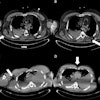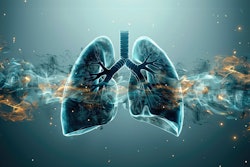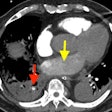Annual lung cancer screening (LCS) in Austria using low-dose CT for a high-risk asymptomatic population would be cost-effective in a national program, despite some uncertainties around healthcare costing data, according to research published at MDPI.
A new Austrian national lung cancer screening modeling study estimated a cost of €945 million in additional screening costs, using volume-based CT over 17 screening rounds, according to the research team led by Hilde ten Berge from the Center for Diagnostic Accuracy and colleagues at the Medical University of Vienna, Johannes Kepler University, and others.
The volume-based CT principle is based on measuring the increase in volume of the lung nodule over time, according to the Center for Diagnostic Accuracy. Volume CT is believed to be a better predictive value for developing lung cancer than looking at the increase in diameter.
Since the Dutch-Belgium NEderlands-Leuvens Longkanker ScreeningsONderzoek (NELSON) trial -- the largest European randomized control trial investigating lung cancer screening -- found a positive effect of low-dose volume CT screening in reducing lung cancer mortality rates, countries throughout the European Union have been establishing and rolling out their programs.
In Germany, national lung cancer screening began on 1 July. The modeling study cites data from Italy as well. And, as of June 2023, the U.K. was set for annual targeted lung health checks (TLHC), rolling out screening mostly with mobile scanning units parked in convenient places, such as supermarket car parks.
The Austrian Society of Roentgenology and the Austrian Society of Pneumology have recommended lung cancer screening implementation in Austria, the authors noted. Moreover, there is an intention to initiate the implementation of screening pilots to evaluate the practical and socioeconomic aspects of screening in the country.
For the Austria study, researchers used a base-case analysis to assess the cost-effectiveness of screening versus no screening program. They considered cost data associated with CT scanning in Germany and Italy, rather than comparing the models themselves.
The study involved 17 screening rounds, determined by referencing the mean age of participants (58 years) and the upper boundary of the age inclusion criteria based on the NELSON study (74 years). Ten Berge and colleagues estimated a 24% mortality reduction as a result of implementing a nationwide lung cancer screening program.
At an uptake rate of 50%, 300,277 eligible individuals would participate in the program. Annual screening would yield 56,122 incremental quality-adjusted life years (QALYs) and 84,049 life years gained compared to no screening, with an incremental cost-effectiveness ratio (ICER) of €24,627 per QALY gained or €16,444 per life-year saved, the authors noted. This study referenced a CT scan cost of €280 from earlier data sourced from the Austrian National Lung Cancer Audit and the unit cost database of Vienna's Department of Health Economics.
"LCS resulted in a stage shift from late to early-stage detection, with 51% of the lung cancer cases being detected in stage I," wrote ten Berge and colleagues. This stage shift resulted in nearly 12,000 premature lung cancer deaths being averted.
Those eligible would either undergo an annual screening with volume CT until a confirmed diagnosis or choose not to participate. Screening participants with negative screen results would enter the sequent screening in the next year. Individuals who did not participate in the screening, alongside those in the no-screening arm, would be diagnosed through standard clinical care after the presentation of lung-cancer-related symptoms.
For this study, scenario analyses investigated the influence of diverse screening uptake rates, with estimations derived from existing cancer screening programs (colorectal cancer, breast cancer) established in Austria. Scenario analyses also explored reduced CT scan expenses as noted in neighboring countries such as Germany and Italy.
Researchers considered expenses encompassing participant recruitment, screening, diagnostic procedures, treatments, ongoing aftercare care, and palliative care to evaluate the cost-effectiveness from a healthcare payer perspective.
Diagnostic costs included expenses incurred after receiving a positive scan or after the clinical presentation of lung-cancer-related symptoms in the nonscreening cohort and the non-participants, the authors noted. Additional costs were accounted for general practitioner or pulmonologist consultation and CT scans. Aftercare consisted of regular chest CT scans and pulmonologist consultations following the initial treatments.
An important point ten Berge and colleagues made is that the use of AI as an impartial reader is expected to "drastically reduce" the workload of radiologists in the future by reducing CT scanning costs.
"Another European country moving towards implementation is a very good sign," former president of the European Society of Thoracic Imaging (ESTI) Prof. Marie-Pierre Revel told AuntMinnieEurope.com recently.
Efforts should prioritize the strategic management of budget allocations, specifically targeting reductions in CT scan costs in the context of LCS implementation in Austria, stated ten Berge and colleagues.
The full research is available here.





















